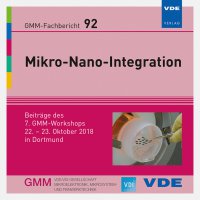Thin film ALD materials as functional layer for 3D-integrated metal oxide gas-sensors
Konferenz: Mikro-Nano-Integration - 7. GMM-Workshop
22.10.2018 - 23.10.2018 in Dortmund, Deutschland
Tagungsband: Mikro-Nano-Integration
Seiten: 6Sprache: EnglischTyp: PDF
Persönliche VDE-Mitglieder erhalten auf diesen Artikel 10% Rabatt
Autoren:
Knauss, A. M.; Muenchenberger, F. M.; Dietz, D.; Jupe, A.; Kappert, H. (Fraunhofer Institute for Microelectronic Circuits and Systems IMS, Duisburg, Germany)
Vogt, H. (Fraunhofer Institute for Microelectronic Circuits and Systems IMS, Duisburg, Germany & University of Duisburg-Essen, Duisburg, Germany)
Inhalt:
We developed the design of an innovative free-floating metal oxide nanowire based gas sensor. The atomic layer deposition (ALD) method is employed for the creation of the gas sensitive wire as well as the free-floating heater structure. For their sacrificial layer based fabrication we propose a simultaneous release. The dependency of the temperature within the nanowire, consisting of zinc oxide (ZnO), with regard to the voltage applied at the heater, made of ruthenium (Ru) or titanium nitride (TiN), and further the gap distance between both free-floating structures were simulated with COMSOL Multiphysics(r). The simulations indicated that TiN exhibits both a more homogeneous temperature distribution within the heater along with lower power consumption necessary for achieving the sensitive temperature range of 220 °C to 350 °C within the ZnO nanowire. Moreover, the technical feasibility of the advanced sacrificial layer process was investigated in the microsystem laboratory successfully demonstrating the practicability of implementation.


